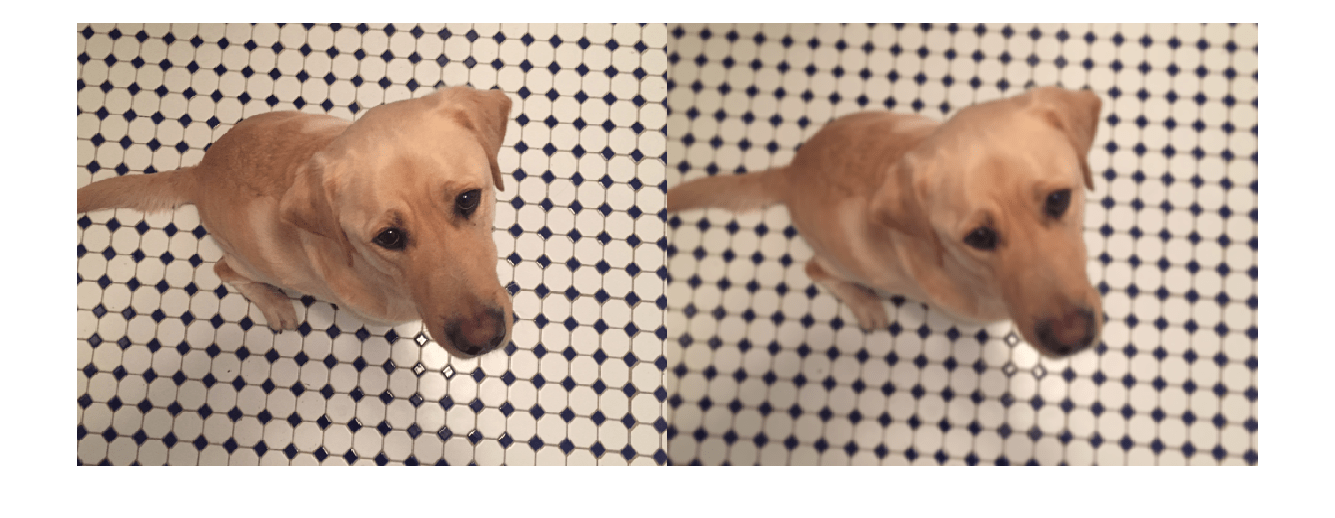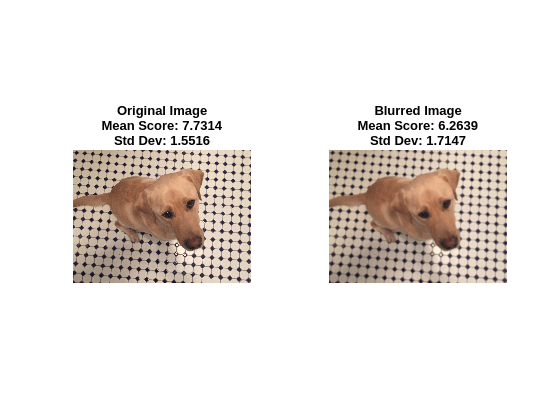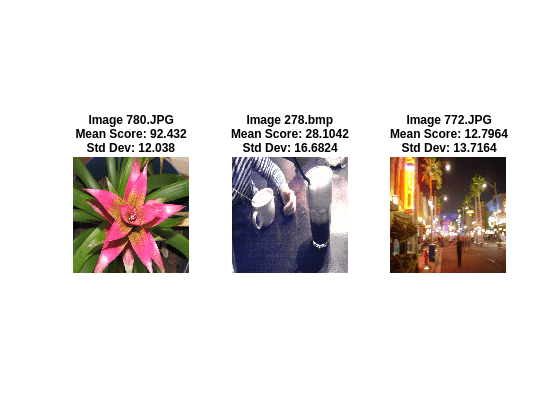Quantify Image Quality Using Neural Image Assessment
This example shows how to analyze the aesthetic quality of images using a Neural Image Assessment (NIMA) convolutional neural network (CNN).
Image quality metrics provide an objective measure of image quality. An effective metric provides quantitative scores that correlate well with a subjective perception of quality by a human observer. Quality metrics enable the comparison of image processing algorithms.
NIMA [1] is a no-reference technique that predicts the quality of an image without relying on a pristine reference image, which is frequently unavailable. NIMA uses a CNN to predict a distribution of quality scores for each image.
Evaluate Image Quality Using Trained NIMA Model
Set dataDir as the desired location of the data set.
dataDir = fullfile(tempdir,"LIVEInTheWild"); if ~exist(dataDir,"dir") mkdir(dataDir); end
Download a pretrained NIMA neural network by using the helper function downloadTrainedNetwork. The helper function is attached to the example as a supporting file. This model predicts a distribution of quality scores for each image in the range [1, 10], where 1 and 10 are the lowest and the highest possible values for the score, respectively. A high score indicates good image quality.
trainedNet_url = "https://ssd.mathworks.com/supportfiles/image/data/trainedNIMA.zip"; downloadTrainedNetwork(trainedNet_url,dataDir); load(fullfile(dataDir,"trainedNIMA.mat"));
You can evaluate the effectiveness of the NIMA model by comparing the predicted scores for a high-quality and lower quality image.
Read a high-quality image into the workspace.
imOriginal = imread("kobi.png"); Reduce the aesthetic quality of the image by applying a Gaussian blur. Display the original image and the blurred image in a montage. Subjectively, the aesthetic quality of the blurred image is worse than the quality of the original image.
imBlur = imgaussfilt(imOriginal,5);
montage({imOriginal,imBlur})
Predict the NIMA quality score distribution for the two images using the predictNIMAScore helper function. This function is attached to the example as a supporting file.
The predictNIMAScore function returns the mean and standard deviation of the NIMA score distribution for an image. The predicted mean score is a measure of the quality of the image. The standard deviation of scores can be considered a measure of the confidence level of the predicted mean score.
[meanOriginal,stdOriginal] = predictNIMAScore(dlnet,imOriginal); [meanBlur,stdBlur] = predictNIMAScore(dlnet,imBlur);
Display the images along with the mean and standard deviation of the score distributions predicted by the NIMA model. The NIMA model correctly predicts scores for these images that agree with the subjective visual assessment.
figure t = tiledlayout(1,2); displayImageAndScoresForNIMA(t,imOriginal,meanOriginal,stdOriginal,"Original Image") displayImageAndScoresForNIMA(t,imBlur,meanBlur,stdBlur,"Blurred Image")

The rest of this example shows how to train and evaluate a NIMA model.
Download LIVE In the Wild Data Set
This example uses the LIVE In the Wild data set [2], which is a public-domain subjective image quality challenge database. The data set contains 1162 photos captured by mobile devices, with 7 additional images provided to train the human scorers. Each image is rated by an average of 175 individuals on a scale of [1, 100]. The data set provides the mean and standard deviation of the subjective scores for each image.
Download the data set by following the instructions outlined in LIVE In the Wild Image Quality Challenge Database. Extract the data into the directory specified by the dataDir variable. When extraction is successful, dataDir contains two directories: Data and Images.
Load LIVE In the Wild Data
Get the file paths to the images.
imageData = load(fullfile(dataDir,"ChallengeDB_release","Data","AllImages_release.mat")); imageData = imageData.AllImages_release; nImg = length(imageData); imageList(1:7) = fullfile(dataDir,"ChallengeDB_release","Images", ... "trainingImages",imageData(1:7)); imageList(8:nImg) = fullfile(dataDir,"ChallengeDB_release","Images", ... imageData(8:end));
Create an image datastore that manages the image data.
imds = imageDatastore(imageList);
Load the mean and standard deviation data corresponding to the images.
meanData = load(fullfile(dataDir,"ChallengeDB_release","Data","AllMOS_release.mat")); meanData = meanData.AllMOS_release; stdData = load(fullfile(dataDir,"ChallengeDB_release","Data","AllStdDev_release.mat")); stdData = stdData.AllStdDev_release;
Optionally, display a few sample images from the data set with the corresponding mean and standard deviation values.
figure t = tiledlayout(1,3); idx1 = 785; displayImageAndScoresForNIMA(t,readimage(imds,idx1), ... meanData(idx1),stdData(idx1),"Image "+imageData(idx1)) idx2 = 203; displayImageAndScoresForNIMA(t,readimage(imds,idx2), ... meanData(idx2),stdData(idx2),"Image "+imageData(idx2)) idx3 = 777; displayImageAndScoresForNIMA(t,readimage(imds,idx3), ... meanData(idx3),stdData(idx3),"Image "+imageData(idx3))

Preprocess and Augment Data
Preprocess the images by resizing them to 256-by-256 pixels.
rescaleSize = [256 256]; imds = transform(imds,@(x)imresize(x,rescaleSize));
The NIMA model requires a distribution of human scores, but the LIVE data set provides only the mean and standard deviation of the distribution. Approximate an underlying distribution for each image in the LIVE data set using the createNIMAScoreDistribution helper function. This function is attached to the example as a supporting file.
The createNIMAScoreDistribution rescales the scores to the range [1, 10], then generates maximum entropy distribution of scores from the mean and standard deviation values.
newMaxScore = 10; prob = createNIMAScoreDistribution(meanData,stdData); cumProb = cumsum(prob,2);
Create an arrayDatastore that manages the score distributions.
probDS = arrayDatastore(cumProb',IterationDimension=2);
Combine the datastores containing the image data and score distribution data.
dsCombined = combine(imds,probDS);
Preview the output of reading from the combined datastore.
sampleRead = preview(dsCombined)
sampleRead=1×2 cell array
{256×256×3 uint8} {10×1 double}
figure
tiledlayout(1,2)
nexttile
imshow(sampleRead{1})
title("Sample Image from Data Set")
nexttile
plot(sampleRead{2})
title("Cumulative Score Distribution")
Split Data for Training, Validation, and Testing
Partition the data into training, validation, and test sets. Allocate 70% of the data for training, 15% for validation, and the remainder for testing.
numTrain = floor(0.70 * nImg); numVal = floor(0.15 * nImg); Idx = randperm(nImg); idxTrain = Idx(1:numTrain); idxVal = Idx(numTrain+1:numTrain+numVal); idxTest = Idx(numTrain+numVal+1:nImg); dsTrain = subset(dsCombined,idxTrain); dsVal = subset(dsCombined,idxVal); dsTest = subset(dsCombined,idxTest);
Augment Training Data
Augment the training data using the augmentDataForNIMA helper function. This function is attached to the example as a supporting file. The augmentDataForNIMA function performs these augmentation operations on each training image:
Crop the image to 224-by-244 pixels to reduce overfitting.
Flip the image horizontally with 50% probability.
inputSize = [224 224]; dsTrain = transform(dsTrain,@(x)augmentDataForNIMA(x,inputSize));
Load and Modify MobileNet-v2 Network
This example starts with a MobileNet-v2 [3] CNN trained on ImageNet [4]. The example modifies the network by replacing the last layer of the MobileNet-v2 network with a fully connected layer with 10 neurons, each representing a discrete score from 1 through 10. The network predicts the probability of each score for each image. The example normalizes the outputs of the fully connected layer using a softmax activation layer.
The imagePretrainedNetwork function returns a pretrained MobileNet-v2 network. This function requires the Deep Learning Toolbox™ Model for MobileNet-v2 Network support package. If this support package is not installed, then the function provides a download link.
dlnet = imagePretrainedNetwork("mobilenetv2");dlnet =
dlnetwork with properties:
Layers: [153×1 nnet.cnn.layer.Layer]
Connections: [162×2 table]
Learnables: [210×3 table]
State: [104×3 table]
InputNames: {'input_1'}
OutputNames: {'Logits_softmax'}
Initialized: 1
View summary with summary.
The network has an image input size of 224-by-224 pixels. Replace the input layer with an image input layer that performs z-score normalization on the image data using the mean and standard deviation of the training images.
inLayer = imageInputLayer([inputSize 3],Name="input",Normalization="zscore"); dlnet = replaceLayer(dlnet,"input_1",inLayer);
Replace the original final classification layer with a fully connected layer with 10 neurons. Add a softmax layer to normalize the outputs. Set the learning rate of the fully connected layer to 10 times the learning rate of the baseline CNN layers. Apply a dropout of 75%.
dlnet = removeLayers(dlnet,["Logits_softmax","Logits"]); newFinalLayers = [ dropoutLayer(0.75,Name="drop") fullyConnectedLayer(newMaxScore,Name="fc",WeightLearnRateFactor=10,BiasLearnRateFactor=10) softmaxLayer(Name="prob")]; dlnet = addLayers(dlnet,newFinalLayers); dlnet = connectLayers(dlnet,"global_average_pooling2d_1","drop");
Define Loss Function
The objective of the NIMA network is to minimize the earth mover's distance (EMD) between the ground truth and predicted score distributions. EMD loss considers the distance between classes when penalizing misclassification. Therefore, EMD loss performs better than a typical softmax cross-entropy loss used in classification tasks [5]. This example calculates the EMD loss using the earthMoverDistance helper function, which is defined in the Supporting Functions section of this example.
For the EMD loss function, use an r-norm distance with r = 2. This distance allows for easy optimization when you work with gradient descent.
Specify Training Options
Specify the options for SGDM optimization. Train the network for 150 epochs.
options = trainingOptions("sgdm", ... InitialLearnRate=3e-3, ... Momentum=0.9, ... MaxEpochs=150, ... LearnRateSchedule="piecewise", ... LearnRateDropPeriod=10, ... LearnRateDropFactor=0.95, ... Plots="training-progress", ... ValidationData=dsVal, ... TargetDataFormats="CB");
Train Network
By default, the example uses the pretrained NIMA network. The pretrained network enables you to run the entire example without waiting for training to complete.
To train the network, set the doTraining variable in the following code to true. Train the model using the trainnet function. Specify the loss function as the earthMoverDistance function. By default, the trainnet function uses a GPU if one is available. Training on a GPU requires a Parallel Computing Toolbox™ license and a supported GPU device. For information on supported devices, see GPU Computing Requirements (Parallel Computing Toolbox). Otherwise, the trainnet function uses the CPU. To specify the execution environment, use the ExecutionEnvironment training option.
doTraining = false; if doTraining dlnet = trainnet(dsTrain,dlnet,@(Y,T)earthMoverDistance(Y,T,2),options) modelDateTime = string(datetime("now",Format="yyyy-MM-dd-HH-mm-ss")); save(fullfile(dataDir,"trainedNIMA-"+modelDateTime+".mat"),"dlnet"); end
Iteration Epoch TimeElapsed LearnRate TrainingLoss ValidationLoss
_________ _____ ___________ _________ ____________ ______________
0 0 00:00:57 0.003 0.23404
1 1 00:01:01 0.003 0.27847
50 8 00:07:40 0.003 0.20513 0.16994
100 15 00:10:58 0.00285 0.19882 0.1522
150 22 00:14:29 0.0027075 0.1602 0.13974
200 29 00:18:20 0.0027075 0.14286 0.13141
250 36 00:21:39 0.0025721 0.1389 0.12671
300 43 00:25:09 0.0024435 0.11931 0.12366
350 50 00:28:40 0.0024435 0.094721 0.12449
400 58 00:32:10 0.0023213 0.10693 0.12123
450 65 00:35:35 0.0022053 0.10294 0.11909
500 72 00:39:27 0.002095 0.092409 0.11691
550 79 00:42:47 0.002095 0.083953 0.11537
600 86 00:46:06 0.0019903 0.082274 0.11445
650 93 00:49:30 0.0018907 0.069274 0.11262
700 100 00:51:58 0.0018907 0.058003 0.11039
750 108 00:54:29 0.0017962 0.061116 0.11066
800 115 00:57:03 0.0017064 0.065334 0.1098
850 122 00:59:33 0.0016211 0.059629 0.10924
900 129 01:02:00 0.0016211 0.059873 0.10979
950 136 01:04:27 0.00154 0.056224 0.10967
1000 143 01:07:03 0.001463 0.054048 0.10897
1050 150 01:09:34 0.001463 0.049354 0.10906
Training stopped: Max epochs completed

dlnet =
dlnetwork with properties:
Layers: [154×1 nnet.cnn.layer.Layer]
Connections: [163×2 table]
Learnables: [210×3 table]
State: [104×3 table]
InputNames: {'input'}
OutputNames: {'prob'}
Initialized: 1
View summary with summary.
Evaluate NIMA Model
Evaluate the performance of the model on the test data set using three metrics: EMD, binary classification accuracy, and correlation coefficients. The performance of the NIMA network on the test data set is in agreement with the performance of the reference NIMA model reported by Talebi and Milanfar [1].
Create a minibatchqueue object that manages the mini-batching of test data.
mbqTest = minibatchqueue(dsTest,MiniBatchSize=options.MiniBatchSize, ... MiniBatchFormat=["SSCB",""]);
Calculate the predicted probabilities and ground truth cumulative probabilities of mini-batches of test data using the modelPredictions function. This function is defined in the Supporting Functions section of this example.
[YPredTest,~,cdfYTest] = modelPredictions(dlnet,mbqTest);
Calculate the mean and standard deviation values of the ground truth and predicted distributions.
meanPred = extractdata(YPredTest)' * (1:10)'; stdPred = sqrt(extractdata(YPredTest)'*((1:10).^2)' - meanPred.^2); origCdf = extractdata(cdfYTest); origPdf = [origCdf(1,:); diff(origCdf)]; meanOrig = origPdf' * (1:10)'; stdOrig = sqrt(origPdf'*((1:10).^2)' - meanOrig.^2);
Calculate EMD
Calculate the EMD of the ground truth and predicted score distributions. For prediction, use an r-norm distance with r = 1. The EMD value indicates the closeness of the predicted and ground truth rating distributions.
EMDTest = earthMoverDistance(YPredTest,cdfYTest,1)
EMDTest =
1×1 single gpuArray dlarray
0.0778
Calculate Binary Classification Accuracy
For binary classification accuracy, convert the distributions to two classifications: high-quality and low-quality. Classify images with a mean score greater than a threshold as high-quality.
qualityThreshold = 5; binaryPred = meanPred > qualityThreshold; binaryOrig = meanOrig > qualityThreshold;
Calculate the binary classification accuracy.
binaryAccuracy = 100 * sum(binaryPred==binaryOrig)/length(binaryPred)
binaryAccuracy = 91.4773
Calculate Correlation Coefficients
Large correlation values indicate a large positive correlation between the ground truth and predicted scores. Calculate the linear correlation coefficient (LCC) and Spearman’s rank correlation coefficient (SRCC) for the mean scores.
meanLCC = corr(meanOrig,meanPred)
meanLCC =
gpuArray single
0.8380
meanSRCC = corr(meanOrig,meanPred,type="Spearman")meanSRCC =
gpuArray single
0.7947
Supporting Functions
Loss Function
The earthMoverDistance function calculates the EMD between the ground truth and predicted distributions for a specified r-norm value. The earthMoverDistance uses the computeCDF helper function to calculate the cumulative probabilities of the predicted distribution.
function loss = earthMoverDistance(YPred,cdfY,r) N = size(cdfY,1); cdfYPred = computeCDF(YPred); cdfDiff = (1/N) * (abs(cdfY - cdfYPred).^r); lossArray = sum(cdfDiff,1).^(1/r); loss = mean(lossArray); end function cdfY = computeCDF(Y) % Given a probability mass function Y, compute the cumulative probabilities [N,miniBatchSize] = size(Y); L = repmat(triu(ones(N)),1,1,miniBatchSize); L3d = permute(L,[1 3 2]); prod = Y.*L3d; prodSum = sum(prod,1); cdfY = reshape(prodSum(:)',miniBatchSize,N)'; end
Model Predictions Function
The modelPredictions function calculates the estimated probabilities, loss, and ground truth cumulative probabilities of mini-batches of data.
function [dlYPred,loss,cdfYOrig] = modelPredictions(dlnet,mbq) reset(mbq); loss = 0; numObservations = 0; dlYPred = []; cdfYOrig = []; while hasdata(mbq) [dlX,cdfY] = next(mbq); miniBatchSize = size(dlX,4); dlY = predict(dlnet,dlX); loss = loss + earthMoverDistance(dlY,cdfY,2)*miniBatchSize; dlYPred = [dlYPred dlY]; cdfYOrig = [cdfYOrig cdfY]; numObservations = numObservations + miniBatchSize; end loss = loss / numObservations; end
References
[1] Talebi, Hossein, and Peyman Milanfar. “NIMA: Neural Image Assessment.” IEEE Transactions on Image Processing 27, no. 8 (August 2018): 3998–4011. https://doi.org/10.1109/TIP.2018.2831899.
[2] LIVE: Laboratory for Image and Video Engineering. "LIVE In the Wild Image Quality Challenge Database." https://live.ece.utexas.edu/research/ChallengeDB/index.html.
[3] Sandler, Mark, Andrew Howard, Menglong Zhu, Andrey Zhmoginov, and Liang-Chieh Chen. “MobileNetV2: Inverted Residuals and Linear Bottlenecks.” In 2018 IEEE/CVF Conference on Computer Vision and Pattern Recognition, 4510–20. Salt Lake City, UT: IEEE, 2018. https://doi.org/10.1109/CVPR.2018.00474.
[4] ImageNet. https://www.image-net.org.
[5] Hou, Le, Chen-Ping Yu, and Dimitris Samaras. “Squared Earth Mover’s Distance-Based Loss for Training Deep Neural Networks.” Preprint, submitted November 30, 2016. https://arxiv.org/abs/1611.05916.
See Also
trainnet | trainingOptions | dlnetwork | imagePretrainedNetwork | imageDatastore | arrayDatastore | transform | minibatchqueue | predict
Related Topics
- Image Quality Metrics (Image Processing Toolbox)
- Datastores for Deep Learning
